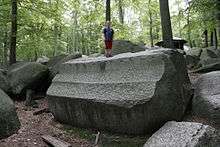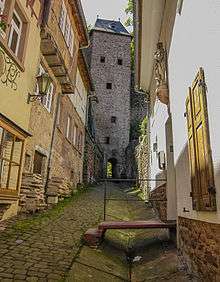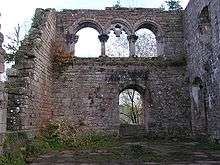Nibelungensteig
The Nibelungensteig is a hiking trail in the Odenwald, a mountain range in the southern part of Hesse, Germany.
The trail starts in Zwingenberg (Bergstraße) and ends in Freudenberg (Main). However, it can be hiked in both directions. The trail is 124 kilometers long, and overcomes 4,000 meters of altitude. The Nibelungensteig leads mostly over naturally made paths.
Labeling
The Nibelungensteig is labeled along the entire trail with a red “N” on a white background.
History
In 2007 the Odenwaldklub[1] was instructed to create a new hiking trail, the Nibelungensteig. The first 40 kilometers of the trail lead from Zwingenberg (Bergstraße) to Grasellenbach (Odenwald). That first section is put together out of local loop trails and was officially opened in October, 2008.[2]
In April 2010, 84 kilometers were added to the first 40 kilometers of the Nibelungensteig. The now 124 kilometers make up the complete trail, leading from Zwingenberg (Bergstraße) to Freudenberg (Main).[3]
In January 2012, the Nibelungensteig was certified as “Qualitätsweg Wanderbares Deutschland” (“Quality Walking in Germany”) by the German Mountain and Walking Clubs Association.[4]
The trail


Three feeder paths lead from the Nibelungenstadt Worms, which belongs thematically to one of the most important locations of the Nibelungensage. The paths then lead through the Hessian Ried to the Nibelungensteig. The three feeder paths include two biking routes (the biking route “north” and the biking route “south”), and one hiking trail.[5]
The first section of the Nibelungensteig was divided into three legs that are between 12 and 15 kilometers long. The first leads from Zwingenberg (Bergstraße) over the Melibokus Mountain and the Felsberg Mountain. At the base of the Felsberg lies the “Felsenmeer” (“rock chaos” or “sea of rocks”)[6] to Reichenbach.[7] When hiking the second leg one passes by the Hohenstein, a quartzite rock on which many people climb, and Lindenfels, a town known as the “pearl of the Odenwald”. From there the third part leads to one of the fountains of Siegfried („Siegfriedbrunnen“), near Grasellenbach. Out of all the fountains of Siegfried in the Odenwald, on which Siegfried von Hagen was supposedly assassinated by Tronje, the one near Grasellenbach is the most famous. Another of the fountains is the „Zittenfeldener Quelle” (spring of Zittenfeld).[8]
The elongation of the Nibelungensteig from 2010 leads through different towns like Amorbach and Miltenberg. Miltenberg contains a historic market place, the so-called “Schnatterloch” (babble hole). It also passes more important landmarks like the Marbach reservoir, which is also used as a swimming lake, the Himbächel viaduct, which is now one of the highest and boldest of all the railway constructions that have been built in Germany, and the „Ebersberger Felsenmeer” (rock chaos of Ebersberg). Furthermore, one can visit the “Quellkirche” (wellspring church), a former pilgrimage site in Schöllenbach, a pilgrimage church in Hesselbach (Hesseneck), which has been dedicated to St. Luzia and St. Odilia.
Other notable sites are:

- the castle “Wildenberg”, on which Wolfram von Eschenbach supposedly wrote his knight epic “Parzival”
- an abbey church with an impressive organ in the baroque town of Amorbach,
- the Martins Chapel, whose furniture includes the so-called “Bilderbibel” (picture bible) in Bürgstadt,
- the “Centgrafenkapelle” (“Tithe Counts’ Chapel”), the relict of a building, which has never been finished as a consequence of the Thirty Years' War, above Bürgstadt,
- and the so-called “Dreiländereck” in Hesseneck. The three German states Baden-Württemberg, Bavaria and Hesse meet here.[9]
Nibelungensteig-Marathon
The Nibelungensteig-Marathon is a so-called “ultramarathon”. It is called this because its distance of 53 kilometers is longer than the usual distance for marathons. The marathon has been taking place once a year, mostly in the fall, since 2008. The runners have to overcome approximately 1,400 meters altitude difference. If those 53 kilometers are too much for someone, one can run with a partner. When running with a partner, one partner runs the first half of the distance and the other runs the second half.
The Marathon is organized by the “Endurance & Dog Sports Nibelungenland”, in cooperation with the “Tourismusmarketing GmbH, Kreis Bergstraße”.[10]
References
- ↑ Odenwaldklub; last accessed on May 15th, 2012.
- ↑ Entstehung des Nibelungensteigs; last accessed on May 15th, 2012.
- ↑ Nibelungensteig führt bis an den Main; last accessed on May 15th, 2012.
- ↑ Erneuter Ritterschlag für Nibelungensteig; last accessed on May 15th, 2012.
- ↑ Dreiklang der Natur - Nibelungensteig; last accessed on May 15th, 2012.
- ↑ Felsenmeer, Felsberg (English); last accessed on May 15th, 2012.
- ↑ Lautertal/ Odenwald (English); last accessed on May 15th, 2012.
- ↑ Der Nibelungensteig; last accessed on May 15th, 2012.
- ↑ Dreiländereck; last accessed on May 15th, 2012.
- ↑ „Nibelungensteig“-Marathon am 1. Oktober; retrieved 7 May 2012.
Further reading
- Rainer Türk: „Auf dem Nibelungensteig" (German). Second edition. Verlag Hubert Brunnengräber, Lorsch. ISBN 978-3-9811444-4-4
- Bettina Rothenheber, Lars Gölz: "Der Nibelungensteig - Eine Bilderreise durch den Odenwald" (German). Worms Verlag. ISBN 978-3-936118-32-2
External links
- Nibelungensteig
- Nibelungensteig (Auf der Homepage des Deutschen Wanderverbandes)
- Nibelungensteig (English)
- Lautertal/ Odenwald (English)
Coordinates: 49°43′33″N 8°36′34″E / 49.72586°N 8.60955°E